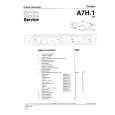|
|
|
Productos
|
|
Información
|
|
Destacado
|
|
|
 |
|
|
No hay comentarios de productos.
clipj and pop the rotary pot shafts into position. The remaining shafts will fall into position. Before snapping the board into its locked position on the standoffs, check that the LEDs are aligned with their respective holes. Seat the board into its locked position. Assemble the washers and nuts to the phone jacks on the Input Connectors board. Make sure that the insulating washer is behind the metal washer on the HEADPHONES jack. Check that the POWER, TEMP WARNING, and SHUTDOWN LEDs are in their proper locations. Replace all knobs. Equalizer Board (A4): This board is located at the center of the foil side of the Output Controls board (A9). Removal requires releasing the nylon standoff locking lugs holding the board in place and pulling the board straight out. Disconnect the wiring harness connectors from J401 and J402. Regulated Power Supply Board (AS): Remove this board by disconnecting connectors J7, J8, and J9, and removing six screws along the edges of the board. Power Amplifier Boards (A6): The two Power Amplifier boards (Model 700) are identical except for mounting brackets. Remove either board by first loosening the PC board-fan assembly. This is accomplished by removing four screws securing the boards to the bottom panel. Select the power amplifier to be removed (channel B amplifier is toward the front of the console and channel A is toward the back). Remove the electromagnetic shield (steel) and electrostatic shield (foil) by disconnecting the grounding lug and disengaging the shields from the nylon standoffs. Disconnect connectors J13 and J14 (for channel B; J10 and J11 for channel A). Remove three screws from the edge of the Power Supply board and, using a small Phillips screwdriver, two screws from the fan. Output Connectors Board (A7): Remove all PATCH BLOCKTM jack retaining nuts and washers, remove board connectors J5 and J6 and unsolder three leads (yellow, green and black) to the MIC OUTPUT jack (PI). The board lifts straight out of the rear of the cover. Output Controls Board (A9): Remove the knobs from the right side of the front panel. Remove the four screws with lockwashers and insulating washers, and disengage the five nylon standoffs securing the board to the front panel. Remove connectors J3, J4, J22, J23, J24 and J25. LED Board ( A l l ) : This board (two boards in the Model 700) can be removed after the Output Controls board (A9) is removed. The LED board is located directly below the equalizer sliders, and can be removed by lifting upward. DC OUTPUT BALANCE ADJUSTMENT In order to eliminate dc offset at the output, a dc balance control (R601, blue) has been provided for each Power Amplifier (A6). This control is accessible from the lefthand side of the console. The dc balance should be checked and adjusted as necessary whenever any Power Amplifier circuit components are replaced. The dc output balance adjustment should be made before making the dc bias current adjustment. The dc balance adjustment is made with all volume controls down and no speaker load. Connect a dc voltmeter (preferably with a 0.1 Vdc full-scale range) across a SPEAKER OUTPUTS jack (J16-J17 for channel A, J18-J19 for channel B).
Use a small screwdriver with an insulated shaft to make this adjustment; hazardous voltages are present in the circuitry near R601. Carefully adjust the dc balance control for 0 Vdc -C20 mV at the output. NOTE: The normal adjustment range of R601 is 1V. If the dc offset exceeds this value, other problems exist in the circuit.
+
DC BIAS CURRENT ADJUSTMENT Each Power Amplifier (A6) contains a dc bias current adjustment control (R617, orange) to set the dc idling current through output transistors Q612-Q615. This adjustment minimizes crossover distortion without drawing excessive idling power. The bias current should be checked whenever any Power Amplifier circuit components are replaced. The adjustment should be made after the dc output balance adjustment. Both dc bias current controls are accessible from the left-hand side of the console. The dc bias current adjustment is made with all volume controls down and no speaker load. Remove the Power Amplifier board shield and connect a dc voltmeter with a floating ground across resistor R632 (0.3 ohms, 7W). See Figures 28-31.
Use a small screwdriver with an insulated shaft to make this adjustment; hazardous voltages are present in the circuitry near R617. Starting with the dc bias current control at full counterclockwise, adjust it for 6 f2 mV across R632. The same voltage should be present across resistors R633, R638 and R639. DB PEAK INDICATORSIFEEDBACK FINDERTM CALIBRATION The following calibration procedures should be performed when parts in the DB PEAK LED strings have been replaced. The potentiometers involved on board A9 are the A DB (R916), B DB (R919), FULL WAVE CAL A (R1044), FULL WAVE CAL B (R1045), and FBF (R972). The balance and dB peak calibrations that follow are given for output channel B; the identical steps for channel A use potentiometers R916 and R1044. All procedures can be performed with the cover open and the Output Controls board in place (see Figure 1). Note that the first two procedures apply to the Model 706 and to channel B of the Model 700. Full Wave Balance 1. Set the console controls to typical settings (orange index marks), the INPUT ATTENuators to 0, and the MASTER controls to 5. 2. Feed a 1 kHz, 150 mV signal from a low-distortion sine-wave signal generator to a channel input HI IMP jack. With an audio voltmeter connected (without a speaker load) to a B SPEAKER OUTPUT jack, adjust the B MASTER or signal generator level control for a 10V output. 3. Connect an oscilloscope across test point TP B (right center of A9) and ground (see Figures 18 and 20).
|
|
 |
> |
|



